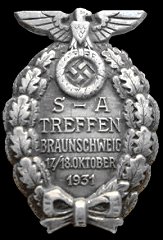The Sturmabteilung was the original paramilitary wing of the Nazi Party. It played a significant role in Adolf Hitler's rise to power in the 1920s and 1930s. Its primary purposes were providing protection for Nazi rallies and assemblies, disrupting the meetings of opposing parties, fighting against the paramilitary units of the opposing parties, especially the Roter Frontkämpferbund of the Communist Party of Germany (KPD) and the Reichsbanner Schwarz-Rot-Gold of the Social Democratic Party of Germany (SPD), and intimidating Romani, trade unionists, and especially Jews.

Ernst Julius Günther Röhm was a German military officer and a leading member of the Nazi Party. A close friend and early ally of Adolf Hitler, Röhm was the co-founder and leader of the Sturmabteilung (SA), the Nazi Party's original paramilitary wing, which played a significant role in Adolf Hitler's rise to power. He served as chief of the SA from 1931 until his murder in 1934 during the Night of the Long Knives.
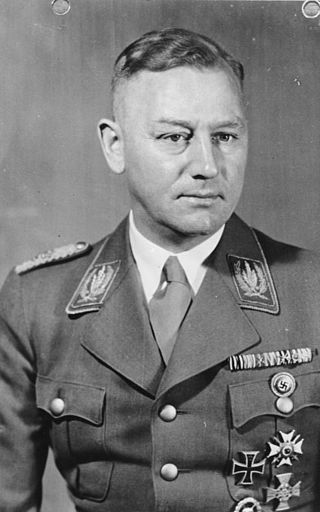
Viktor Lutze was a German Nazi Party functionary and the commander of the Sturmabteilung ("SA") who succeeded Ernst Röhm as Stabschef and Reichsleiter. After he died from injuries received in a car accident, Lutze was given an elaborate state funeral in Berlin on 7 May 1943.
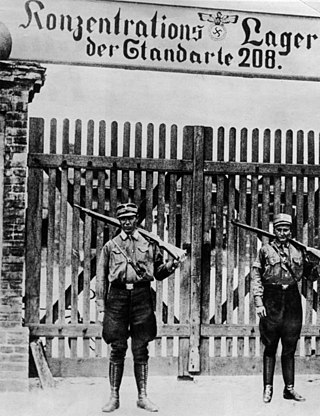
The uniforms and insignia of the Sturmabteilung (SA) were Nazi Party paramilitary ranks and uniforms used by SA stormtroopers from 1921 until the fall of Nazi Germany in 1945. The titles and phrases used by the SA were the basis for paramilitary titles used by several other Nazi paramilitary groups, among them the Schutzstaffel (SS). Early SS ranks were identical to the SA, since the SS was originally considered a sub-organization of the Sturmabteilung.

The Supreme SA Leader, was the titular head of the Nazi Party's paramilitary group, the Sturmabteilung (SA).

Stabschef was an office and paramilitary rank in the Sturmabteilung (SA), the paramilitary stormtroopers associated with the Nazi Party. It was a rank and position held by the operating chief of the SA. The rank is equivalent to the rank of Generaloberst in the German Army and to General in the US Army.
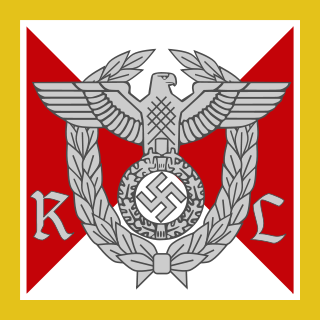
Reichsleiter was the second-highest political rank in the Nazi Party (NSDAP), subordinate only to the office of Führer. Reichsleiter also functioned as a paramilitary rank within the NSDAP and was the highest rank attainable in any Nazi organisation.

The German Order was the highest award that the Nazi Party could bestow on an individual for his services to the "state and party". It was designed by Benno von Arent. Adolf Hitler awarded the first such order posthumously to Reichsminister Fritz Todt during Todt's funeral in February 1942. A second posthumous award of the German Order was given to SS-Obergruppenführer Reinhard Heydrich at his funeral in June that year. Cynics called the award the "dead hero order" as it was almost always awarded posthumously. The only two recipients who received the German Order and survived the war were Konstantin Hierl and Artur Axmann.

The Blood Order, officially known as the Decoration in Memory of 9 November 1923, was one of the most prestigious decorations in the Nazi Party (NSDAP). During March 1934, Hitler authorized the Blood Order to commemorate the 9 November 1923 coup attempt of the Nazi Party. The medal is silver, with the obverse bearing a depiction of an eagle grasping an oak leaf wreath. Inside the wreath is the date 9.Nov. and to the right is the inscription München 1923–1933. The reverse shows the entrance of the Feldherrnhalle in relief, and directly above is the angled swastika with sun rays in the background. Along the top edge is the inscription: UND IHR HABT DOCH GESIEGT.
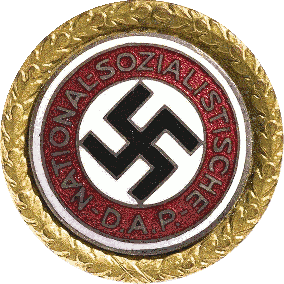
The Golden Party Badge was an award authorised by Adolf Hitler in a decree in October 1933. It was a special award given to all Nazi Party members who had, as of 9 November 1933, registered numbers from 1 to 100,000 and had unbroken Party membership. The recipient's party number was inscribed on the reverse of the badge. Only 20,487 men and 1,795 women were awarded the badge on these terms.

Political decorations of the Nazi Party were medals and awards issued by the National Socialist German Workers Party (NSDAP) between 1920 and 1945. Political awards were authorized for wear on any paramilitary uniform of Nazi Germany, as well as civilian attire, but were generally discouraged on Wehrmacht military uniforms. The Waffen-SS freely wore both political awards and military decorations on their uniforms.

Adolf Hühnlein was a German soldier and Nazi Party (NSDAP) official. He was the Korpsführer of the National Socialist Motor Corps (NSKK) from 1933 until his death in 1942.
The term Frontbann refers to a reorganized front organization of the Sturmabteilung or SA which was formed in April 1924. It was created to replace the SA which had been banned in the aftermath of the failed Munich Putsch. It was disbanded in February 1925 after the ban on the SA was lifted.
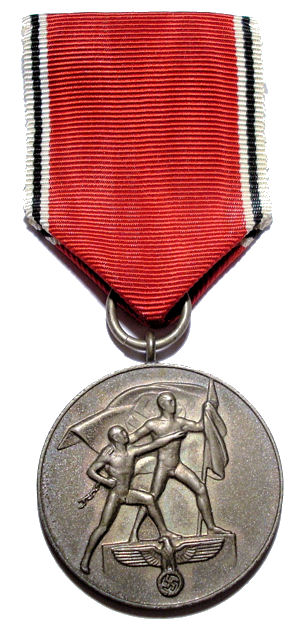
The Anschluss Commemorative Medal was a decoration of Nazi Germany awarded during the interwar period, and the first in a series of Occupation Medals.
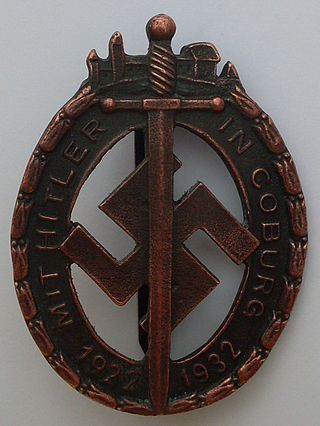
The Coburg Badge was the first badge recognised as a national award of the Nazi Party (NSDAP).
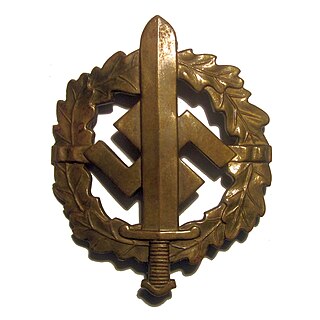
The SA Sports Badge was a decoration of Nazi Germany that was issued between the years 1933 and 1945. It was a political version of the much more generic German Sports Badge, which was also issued in great numbers by the Nazis. At its center was a 57mm high Roman broad sword, superimposed over a Nazi swastika encircled by an wreath of oak leaves. It was a pin-back badge, but there was a cloth version, as well.

The Nuremberg Party Day Badge was a highly revered political decoration of the Nazi Party (NSDAP). It was the second badge recognised as a national award of the party.
The Nazi Party Long Service Award, sometimes called the NSDAP Long Service Award, was a political award in the form of a badge of the Nazi Party.

The German Horseman's Badge also referred to in general terms as the German Equestrian Badge, was a sports decoration of the Weimar Republic and Nazi Germany. It was awarded for proficiency in riding horses. Equestrian badges remain a part of German rider training today, although their appearance is completely different.
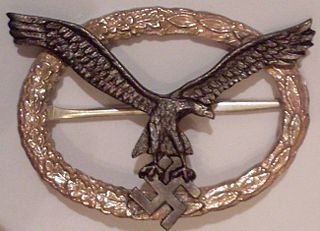
The Aircrew Badge was a German military decoration awarded to members of the German Air Sports Association, an organisation set up by the Nazi Party in March 1933 to establish a uniform basis for the training of military pilots. The German Air Sports Association was a cover organization for the future German Air Force (Luftwaffe). Its chairman was the future Commander in Chief of the Luftwaffe Hermann Göring and its vice-chairman Ernst Röhm. Since the Treaty of Versailles officially forbade Germany from building fighter planes of any sort, the German Air Sports Association used gliders to train men who were still officially civilians for the future Luftwaffe. It was the first qualification badge recognized by the Luftwaffe.
